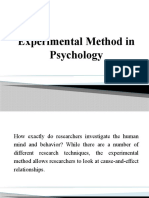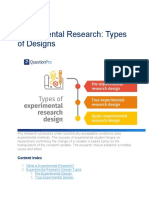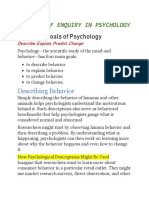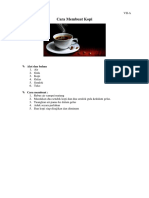Lesson-3-Hypotheis
Uploaded by
Jeanelle VillamayorLesson-3-Hypotheis
Uploaded by
Jeanelle VillamayorUnderstanding Hypothesis in Research and Capstone Projects
Introduction to Hypothesis
📌 Key Points:
A hypothesis is a statement that predicts a relationship between two or
more variables.
It is the foundation for research studies, guiding data collection and analysis.
In capstone projects, a hypothesis helps establish a clear research focus.
📌 Example:
A study on student performance may have the hypothesis:
“Students who study for at least 3 hours a day will achieve higher test scores
than those who study less.”
Characteristics of a Good Hypothesis
📌 Key Features:
Testable: Can be examined through experiments or data collection.
Measurable: Should involve quantifiable variables.
Clear & Specific: Avoids vague or ambiguous language.
Based on Prior Knowledge: Derived from literature review or existing
research.
📌 Example:
❌ Bad Hypothesis: “Exercise is good for health.” (Too vague)
✅ Good Hypothesis: “Individuals who engage in 30 minutes of aerobic
exercise daily have lower blood pressure levels than those who do not.”
Role of Hypothesis in Research
📌 Why is a hypothesis important?
1. Guides the research process: Provides a clear research focus.
2. Establishes relationships: Helps identify how one variable influences
another.
3. Enables testing of theories: Helps researchers validate or refute scientific
ideas.
📌 Example:
Research Topic: Effect of social media on academic performance.
Hypothesis: "Students who spend more than 3 hours daily on social media
have lower academic performance compared to those who spend less time."
Types of Hypotheses
📌 Two Main Types:
Null Hypothesis (H₀): States that there is no effect or relationship.
Alternative Hypothesis (H₁): Predicts an effect or relationship between
variables.
📌 Example:
H₀ (Null Hypothesis): "There is no difference in stress levels between
students who meditate and those who do not."
H₁ (Alternative Hypothesis): "Students who meditate experience lower
stress levels than those who do not."
Null Hypothesis (H₀)
📌 Key Points:
The null hypothesis assumes that any observed difference is due to chance.
Researchers often attempt to reject the null hypothesis to show a
meaningful effect.
📌 Example:
A drug study may have the null hypothesis:
"The new medication has no significant effect on blood sugar levels."
Alternative Hypothesis (H₁)
📌 Key Points:
The alternative hypothesis suggests that there is a meaningful relationship
between variables.
It is the statement researchers aim to prove.
📌 Example:
A fitness study may propose:
"A high-protein diet results in greater muscle gain than a regular diet."
Directional vs. Non-Directional Hypotheses
📌 Key Differences:
1. Directional Hypothesis: Specifies the expected direction of the effect
(increase or decrease).
o Example: "Students who get 8+ hours of sleep score higher than
those who get less sleep."
2. Non-Directional Hypothesis: States a difference will occur but doesn’t
specify the direction.
o Example: "There is a difference in test scores between students who
sleep 8+ hours and those who sleep less."
Research Hypothesis vs. Statistical Hypothesis
📌 Differences:
Research Hypothesis: A general prediction based on a research question.
Statistical Hypothesis: A numerical statement tested using statistical
methods.
📌 Example:
Research Hypothesis: "Physical activity affects mental health."
Statistical Hypothesis: "People who exercise 3+ times per week have a
mean anxiety score of 2.5 or lower."
Hypothesis vs. Research Questions
📌 Key Distinctions:
Research Questions: Open-ended, exploratory.
o Example: "What factors affect students' study habits?"
Hypotheses: Predictive statements based on relationships between
variables.
o Example: "Students who study 3+ hours daily have higher grades."
Formulating a Hypothesis (Steps)
📌 Steps to Create a Strong Hypothesis:
1. Identify a research problem.
2. Conduct a literature review.
3. Define independent and dependent variables.
4. Construct a clear hypothesis.
📌 Example:
Topic: "Does caffeine improve memory?"
Hypothesis: "Participants who consume caffeine before a memory test will
score higher than those who do not."
Variables in a Hypothesis
📌 Key Terms:
Independent Variable (IV): The cause or factor manipulated.
Dependent Variable (DV): The effect or outcome measured.
📌 Example:
Hypothesis: "Daily exercise improves heart health."
o IV: Daily exercise
o DV: Heart health
Hypothesis in Quantitative vs. Qualitative Research
📌 Comparison:
Quantitative: Uses hypotheses to test relationships with numerical data.
Qualitative: Rarely uses hypotheses (focuses on open-ended exploration).
📌 Example:
Quantitative: "Students using digital textbooks score higher on tests than
those using printed books."
Qualitative: "How do students feel about using digital textbooks?"
Examples of Well-Written Hypotheses
📌 Examples of Strong Hypotheses:
"Employees who work from home are more productive than those who work
in offices."
"Listening to classical music improves concentration in students."
Testing a Hypothesis
📌 Steps in Hypothesis Testing:
1. Collect data
2. Analyze results using statistics
3. Draw conclusions
📌 Example:
Using t-tests to compare student performance before and after a study
technique intervention.
Hypothesis Errors (Type I & Type II)
📌 Key Errors:
Type I Error: False positive (rejecting a true null hypothesis).
Type II Error: False negative (failing to reject a false null hypothesis).
📌 Example:
Type I: A test wrongly shows a new drug works.
Type II: A test fails to detect that a drug actually works.
Importance of a Hypothesis in Capstone Projects
📌 Why is it crucial?
Helps structure the research.
Ensures valid and reliable study design.
Common Mistakes in Hypothesis Formulation
📌 Avoid These Errors:
Being too vague.
Using subjective terms (e.g., “better” instead of measurable terms like
“higher test scores”).
Summary & Key Takeaways
📌 Recap:
Hypothesis = essential research tool.
Should be clear, testable, and specific.
You might also like
- Laerdal Infant Airway Management TrainerNo ratings yetLaerdal Infant Airway Management Trainer7 pages
- Proses Utama Penyelidikan Kuantitatif W4No ratings yetProses Utama Penyelidikan Kuantitatif W444 pages
- Types of Hypothesis in Research Methodology With Examples100% (2)Types of Hypothesis in Research Methodology With Examples6 pages
- How To Include A Hypothesis in A Research Paper100% (3)How To Include A Hypothesis in A Research Paper4 pages
- How The Experimental Method Works in Psychology-1No ratings yetHow The Experimental Method Works in Psychology-155 pages
- Writing Approach in The Background of The StudyNo ratings yetWriting Approach in The Background of The Study7 pages
- WEEK 9 - Hypothesis 11032022 113649am 21022023 104041am 05102023 120649pmNo ratings yetWEEK 9 - Hypothesis 11032022 113649am 21022023 104041am 05102023 120649pm44 pages
- Hypothesis- Characteristics,Types,Sources and Problems in Formulation of Hypothesis.No ratings yetHypothesis- Characteristics,Types,Sources and Problems in Formulation of Hypothesis.13 pages
- EXPEREMENTAL Experimental Research Is A StudyNo ratings yetEXPEREMENTAL Experimental Research Is A Study7 pages
- How Do You Write A Hypothesis For A Research Paper100% (2)How Do You Write A Hypothesis For A Research Paper6 pages
- Developing A Hypothesis For A Research Paper100% (1)Developing A Hypothesis For A Research Paper5 pages
- How To Find A Hypothesis in A Research PaperNo ratings yetHow To Find A Hypothesis in A Research Paper8 pages
- Gathering of Information From Survey, Experiments or Observation100% (2)Gathering of Information From Survey, Experiments or Observation5 pages
- Module 1 - Introduction To Research Methods0No ratings yetModule 1 - Introduction To Research Methods038 pages
- Las Practical Research2 Research HypothesisNo ratings yetLas Practical Research2 Research Hypothesis7 pages
- How To Include Hypothesis in Research Paper100% (2)How To Include Hypothesis in Research Paper5 pages
- MY THOUGHTS ABOUT "A Beautiful Mind": Daro, Farhannah T. Bsn-3No ratings yetMY THOUGHTS ABOUT "A Beautiful Mind": Daro, Farhannah T. Bsn-31 page
- © Ncert Not To Be Republished: The World PopulationNo ratings yet© Ncert Not To Be Republished: The World Population9 pages
- Types of Hypothesis in Research Methodology With ExamplesTypes of Hypothesis in Research Methodology With Examples
- WEEK 9 - Hypothesis 11032022 113649am 21022023 104041am 05102023 120649pmWEEK 9 - Hypothesis 11032022 113649am 21022023 104041am 05102023 120649pm
- Hypothesis- Characteristics,Types,Sources and Problems in Formulation of Hypothesis.Hypothesis- Characteristics,Types,Sources and Problems in Formulation of Hypothesis.
- How Do You Write A Hypothesis For A Research PaperHow Do You Write A Hypothesis For A Research Paper
- Gathering of Information From Survey, Experiments or ObservationGathering of Information From Survey, Experiments or Observation
- MY THOUGHTS ABOUT "A Beautiful Mind": Daro, Farhannah T. Bsn-3MY THOUGHTS ABOUT "A Beautiful Mind": Daro, Farhannah T. Bsn-3
- © Ncert Not To Be Republished: The World Population© Ncert Not To Be Republished: The World Population

























































































